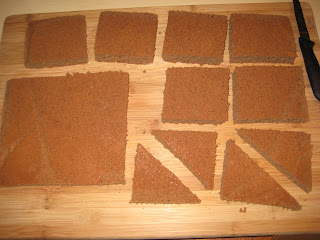I am going to go out on a limb here and say... this might be my new favorite recipe. No, it's not a cupcake. But it's not quite a cookie. You might be blown away by exposure to pure awesomeness.
The cookie stand at the mall where I grew up sometimes had "peanut butter cup" cookies, which are peanut butter cookies filled with chocolate fudge/frosting. It has been always my favorite thing to get. But, sadly, I don't live there anymore, and have gone quite a few years without being able to enjoy them. But then, I found this recipe and have re-created them, almost exactly! And the bonus: this recipe is incredibly easy to make. Let the world rejoice with yet another way to enjoy the classic chocolate/peanut butter combination!
FUDGE PUDDLES
Preheat the oven to 325 degrees. Get out your mini muffin pans (this recipe makes approx. 48 minis - you could also make them in a regular size, but then people won't eat as much... just a thought!) I greased my pans to ensure that I could easily remove the cookie. You could also use liners. Or do nothing and risk it. It's entirely up to you.
For the cookie:
- 1/2 cup butter, softened
- 1/2 cup creamy peanut butter
- 1/2 cup white sugar
- 1/2 cup packed brown sugar
- 1 egg
- 1/2 teaspoon vanilla extract
- 1 1/4 cups all-purpose flour
- 3/4 teaspoon baking soda
- 1/2 teaspoon salt
Cream the butter, peanut butter and sugars together. "Cream" is kind of a misnomer here - it will not get light and fluffy like a normal butter/sugar combo will. Instead, just mix it until it all looks cohesive and is one color.
Add the egg and vanilla - mix.
Add the sifted ingredients and mix again. You will get a very yummy peanut butter cookie dough at this point.
Now, form the dough into 1-inch balls. Place into the muffin pans.
I baked mine at 325 for 12 minutes. This is because my oven is old, bakes unevenly, and likes to destroy desserts. If your oven is not the spawn of Satan, you could probably leave them in for 14-16 minutes. You want them to just start turning golden.
Once you take them out of the oven, you need to immediately make the "wells" for the fudge. You should have peanut butter cookies that look like small muffins. Using a melon baller, a mortar and pestle, or any other object that fits the bill, press a divot into the center of each cookie-muffin. (Cookie-muffin... that would be a really fun term of endearment. I wonder how long I can use it until my husband tells me to knock it off?) Anyway, you want to press it down far enough to get a good amount of fudge in there, but not so far that you can push through to the bottom. If you push down and your cookie becomes almost transparent, don't go as far with the next one:-)
Let them sit in the pan for about five minutes, and then remove to a wire cooling rack.
Now it's time for the amazingly awesome fudge frosting!
FUDGE
- 1 cup milk chocolate chips
- 1 cup semi-sweet chocolate chips
- 1 (14 ounce) can sweetened condensed milk
- 1 teaspoon vanilla extract
- 3/4 cup pecan halves (optional)

Make sure to stir it constantly. This won't take too long, but be patient and make sure you get it really smooth!
Add the sweetened condensed milk and vanilla. Stir quickly to combine.
Your mixture should now be getting pretty thick. At this point, you can fill the peanut butter cups with your fudge-like chocolate frosting mixture! There are several ways to do this. For my first attempt, I just spooned it in using a tablespoon. It still tasted great, but I wasn't entirely satisfied with the way it looked:
I also found that the chocolate kept getting firmer and firmer the longer it took to fill, so I had to keep mixing it up in the bowl after every few cookies were filled. For my second attempt, I used a decorating tip and my handy-dandy "Dessert Decorator Pro" (a combination of gifts from both my mom and mother-in-law). Using a very large tip (so the thick chocolate wouldn't get stuck), I was able to fill the cups much faster, with much less mess, and I didn't have to worry about it firming up (because the chocolate that was waiting to go into a cup was still being moved through the decorator, it stayed soft until entering the peanut butter cup). If you don't have any fancy decorating tools, I might recommend using a gallon-sized ziploc bag. Fill it with the chocolate, cut a hole in one corner and fill that way.
This was my finished product:
Enjoy!

































